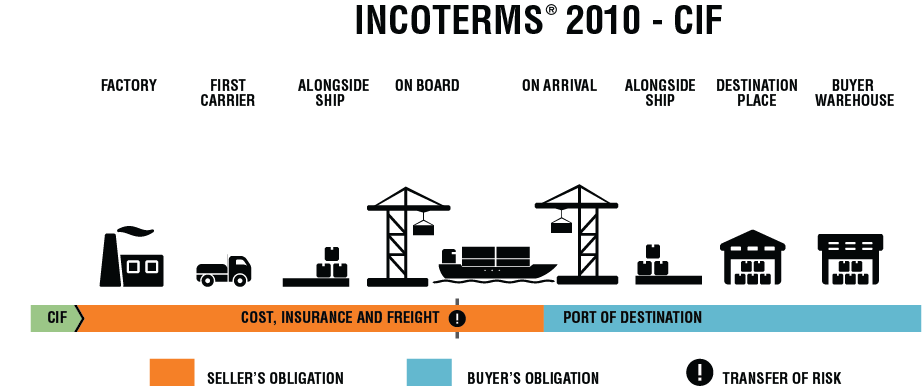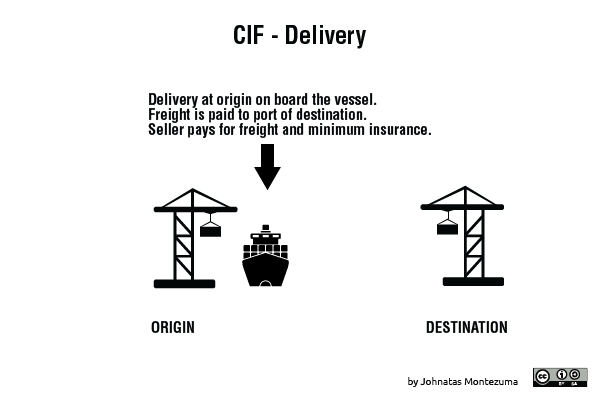CIF – Cost, Insurance and Freight paid to … (Port of Destination)
Characteristics
In CIF terms, the seller clears the goods at origin places the cargo on board and pays for insurance until port of discharge at minimum cover. Even though the seller pays for insurance during the main carriage, the risk is transferred to the buyer at time the goods are on board. The term is used for ocean and inland waterway transportation only
This term is commonly used in bulk cargo, oil and oversized.

Source: internationalcommercialterms.guru
Explained
Deliver happens in the port of loading, risk for seller ends at port of discharge and must adquire insurance coverage. In addition to this, seller must arrange international freight transportation and provide all documentation to buyer. Seller must also clear exports customs.
This term is exclusively used on ocean transportation. If cargo doesn’t fit into a container, use CIT. This term is commonly used for agricultural or chemical products where seller has expertise and buying power on loading and transportation until port of discharge and capacity to insure goods.

Examples
Buying scrap metal from Thailand (scrap metal also gets insured):
CIF Shanghai Port, China
Seller and Buyer obligations
| THE SELLER’S OBLIGATIONS | THE BUYER’S OBLIGATIONS |
|---|---|
| 1. Provision of goods The seller must deliver the goods, provide commercial invoice or an equivalent electronic document, provide evidence of conformity or proof of delivery | 1. Payment The buyer must pay the price of goods as agreed in the contract of sale |
| 2. Licences, authorisations and formalities The seller must provide export licenses or local authorizations for exporting goods | 2. Licences, authorisations and formalities The buyer must get any export license for the export of goods |
| 3. Contracts of carriage and insurance The seller must contract on usual terms at his own expense for the carriage of the goods to the named port of destination by the usual route in a seagoing vessel (or inland waterway vessel as the case may be) of the type normally used for the transport of goods of the contract description. Contract of insurance: no obligation | 3. Contracts of carriage and insurance Contract of carriage: no obligation Contract of insurance: no obligation |
| 4. Delivery The seller must deliver the goods on board the ship | 4. Taking delivery Take delivery of the goods at the agreed port of destination |
| 5 Transfer of risks The seller is responsible until goods passed the rail’s ship | 5 Transfer of risks The buyer must bear all risks of loss of or damage from the time the goods have been delivered on board |
| 6. Costs The seller must pay all cost until delivery on board, loading cost and carriage until port of destination, insurance from origin and main carriage and all export duties and taxes and customs formalities | 6. Costs The buyer pays for all cost relating since goods are on board, unloading cost unless they are included in the contract of carriage, customs and taxes at destination as well as formalities |
| 7. Notice to the buyer The seller must notify the buyer that goods have been delivered | 7. Notice to the seller The buyer must provide time of shipment and port of destination |
| 8. Proof of delivery, transport document or equivalent electronic message At his own expense, transport documentation with on board date in full set when originals are printed. | 8. Proof of delivery, transport document or equivalent electronic message Accept sellers transportation document in comformity |
| 9. Checking The seller must bear the cost of checking, quality control, measuring, weighing, counting, packing of goods and marking. If special package is required, the buyer must inform and the seller and agreed on extra expenses | 9. Inspection Unless it’s a mandatory at origin, pay any pre-shipment inspection |
| 10. Other Assist obtaining additional information required by the seller | 10. Other Assist obtaining additional information required by the seller |